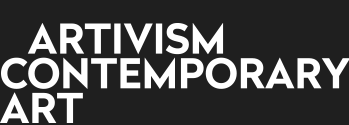6 / Isabelle De Maison Rouge
Isabelle De Maison Rouge, Curator and Art Historian
Behind the scenes of the movement #6
Isabelle De Maison Rouge : L’artiste peux avoir un véritable rôle dans la société. Il va nous ouvrir les yeux sur des éléments et des choses que l’on ne perçoit pas et l’avantage c’est qu’il a un rôle qui n’est pas celui du journaliste, ou du politique, il est même bien éloigné de tout ça. Je pense que cet «Art Politique» qui prend des positions on en a vraiment besoin et je pense qu’il a toute sa place. Il n’a pas à jouer un rôle précis, avec des preuves à l’appuis, mais simplement par son regard, par la façon qu’il va nous amener à regarder nous même, on va pouvoir s’interroger et voir ce qu’il y a derrière cela, est-ce que l’on nous dit vraiment la vérité… L’idée c’est qu’ensuite nous soyons avertit, que l’on aille chercher la vérité par sois même et pas attendre que l’on trouve tout dans la presse car l’on sait que l‘on ne les trouvera pas. L’artiste ce n’est pas quelqu’un qui vient faire du décor, mais c’est quelqu’un qui a une arme, l’art est véritablement une arme.
Les médias lorsqu’ils parlent des artistes et de l’art contemporain n’est qu’une toute petite partie émergée de l’iceberg et en réalité ce qui se passe de réellement intéressant est en dessous. L’art est totalement inscrit dans notre époque, il suit le phénomène de la « Financiarisation » qui se retrouve partout. On voit bien comment l’argent domine le monde et aussi cette notion de globalisation, l’art est devenu international, global, tenu par l’argent, il n’a donc pas échappé à ce phénomène général. Comme l’art est devenu très à la mode ça a attiré des gens qui au départ n’étaient pas sensibilisés par cela mais qui ont fait des fortunes phénoménales et leur on permis de montrer le pouvoir qu’ils ont à pouvoir acheter des oeuvres à des prix gigantesques.
La véritable question concerne la valeur de l’art. On peux l’approcher de différentes façons, il y a la valeur économique, marchande, mais ce n’est pas ça qui est intéressant, mais le problème c’est qu’actuellement le marché parle plus fort que l’art donc la valeur artistique, la valeur esthétique, la valeur intellectuelle de l’art. Pour le moment on la voit beaucoup moins pourtant ce qui compte c’est ce que l’artiste explique, signifie, ce qu’il amène à regarder mais ça c’est une autre forme de valeur, mais elle est immatérielle et beaucoup plus complexe à percevoir et plus complexe à faire passer aussi.
Isabelle De Maison Rouge : The artists can have a true role in society; they are going to open our eyes on elements and things we do not perceive. And the good thing is that his role is different from a journalist’s, or a politician’s, it is even quite far away from all that I think that this “political art” which takes a stand, well we really need it and its presence is legitimate. I don’t think it’s supposed to play any specific part, with evidence to prove it, but simply through its eye, through the way it will make us look.
Well, we’re going to be able to wonder and see what’s behind that, are we really told the truth? And then the point is that we are warned, that we go look for the truth ourselves and not expect to find it all in the press, for we know that we won’t find it.
The artists are not doing some kind of décor, they have a weapon, art really is a weapon. When the media talk about artists and contemporary art, it’s only the tip of the iceberg and what’s really interesting is happening underneath. Art is totally a part of our time, it follows the phenomenon of the “financialization” that we find everywhere; we can easily see how money rules the world. And the notion of globalization too, art has become international, global, held by money, it has thus not escaped from this general phenomenon.
Art became very fashionable so it attracted people who weren’t educated to it but still made huge fortunes. And enabled them to show their power to buy those pieces at incredibly high prices. The true question is the value of art and you can address it in different ways. The economic, market value, but that’s not interesting. And the problem is that right now, the market speaks louder than art. So we see the artistic, aesthetic and intellectual values of art much less. And yet, what matters is that the artist explains and signifies what he wants people to look at. But that’s another kind of value; it is immaterial and far more complex to perceive and to pass on too.
Directed : Amine Bouziane
Original concept : Stéphane Chatry
Traduction : Marion Bouvet
Partners : Stuff Productions and ViewOn


